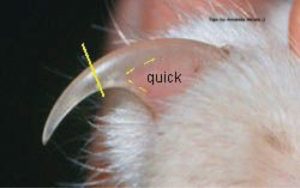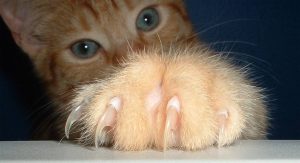For this edition, I’d like to take the time to answer the most common question that I have received over the past year or so. This question was asked by about 30 of our readers from the United States, Canada, and Europe.
Nail Trimming as an Alternatives to declawing cats
The question we are trying to answer is: What is the best way to deal with my cats claws? Is declawing a cat the right thing to do? Are there any alternatives to declawing my cat?
Many of our readers ask this questions because they find that their cat will use furniture, carpet, rugs, or even wood trim as a scratching post. So if you don’t have a dedicated cat scratching post start by getting one!
Many of our readers also say they are pressured by their family members to have their cats declawed so they can stop having their furniture or homes damaged by the darn cat!
The answer to the age old question of how to deal with your clawing cat can be answered by another one of our veterinarian readers who suggests that declawing is not a natural thing for a cat and is distinctly different than trimming our (human) nails.
Declawing has become one of the hottest debated subject among cat lovers, haters, and owers. Cats are born with claws for many reasons ranging from hunting, playing, and climbing. And because of these reasons they should keep their claws.
Annie writes, that she would never have her cat or another cat declawed again. After she de-clawed her first cat she noticed a distinct change in the cats behavior including problems balancing stress, proper use of the litter box, substituting biting for clawing, and many more. She also writes that she was present for the surgery and that the process seemed painful for the cat.
Declawing Impact on Cats and the human equivalent
Furthermore, when declawing a cat, it is far more than just trimming their nails. The declawing process removes the section of bone from the cat’s paw where the claw would normally grow. To picture this on yourself would be the equivalent of having your fingertips chopped off.
Making the Scratching Post More Appealing to your Cat
Make sure that the scratching post that you provide your cat offers many different materials such as wood, fabric, or other textures. Understanding the areas that your cat likes ensure the proper use of the post. This includes having both horizontal as well as vertical scratching options.
Move the scratching post next to the areas where your cat is troubling your furniture. Give the cats an option between the naughty scratching area and the scratching post. You can even stack the deck in your favor by spraying or smothering the scratching post with catnip.
If making the post more desirable doesn’t work try making the furniture or troubled area less desirable. Cats detest areas covered with clear masking tape.
Final Option: Trimming your cat’s nails
I am a strong advocate for trimming your cat’s nails as a last resort. If your cat is a friendly lap kitty, then this task may be a breeze. If your cat is not such a people person it may be a good idea to take them to the veterinarian and pay to have their claws trimmed.

The benefits of trimming nails for your cat is to allow for the old claw tissue to be removed and regrown. If your cats nail tissue does not wear down and become replaced, the nail will grow into a very sharp spike causing nasty cuts to you and potentially your furniture and upholstery.
Many other options exist including a kitty nail claw cap. If your cat doesn’t like its nails being trimmed, try adding a soft pad to cover the nail spike.
How to Trim nails on a cat who doesn’t like their paws being touched
If you’re like our reader Austin, his cat doesn’t like their paws being touched. This makes trimming the nails extremely difficult. The trick he learned from his veterinarian was to hold the cat and slowly massage the cats paws when the cat is on your lap. Feel the sharp tips of the nails by slowly pressing in the middle of the paw pad while you are massaging your kitties feet. As the nail is pressed outward, trim the clear section of the nail while leaving the pink area untrimmed.
Be sure to reward your cat after you trim their nails so they remember it as a pleasurable experience. That way next time, it will be that much easier.
Happy trimming!

